Upgrading from an Intel Core i7-2600K: Testing Sandy Bridge in 2019
by Ian Cutress on May 10, 2019 10:30 AM EST- Posted in
- CPUs
- Intel
- Sandy Bridge
- Overclocking
- 7700K
- Coffee Lake
- i7-2600K
- 9700K

One of the most popular processors of the last decade has been the Intel Core i7-2600K. The design was revolutionary, as it offered a significant jump in single core performance, efficiency, and the top line processor was very overclockable. With the next few generations of processors from Intel being less exciting, or not giving users reasons to upgrade, and the phrase 'I'll stay with my 2600K' became ubiquitous on forums, and is even used today. For this review, we dusted off our box of old CPUs and put it in for a run through our 2019 benchmarks, both at stock and overclocked, to see if it is still a mainstream champion.
If you want to see all of our Core i7 benchmarks for each one of these CPUs, head over to anandtech.com/Bench
Why The 2600K Defined a Generation
Sit in a chair, lie back, and dream of 2010. It's a year when you looked at that old Core 2 Duo rig, or Athlon II system, and it was time for an upgrade. You had seen that Nehalem, and that the Core i7-920 was a handy overclocker and kicking some butt. It was a pleasant time, until Intel went and gave the industry a truly disruptive product whose nostalgia still rings with us today.
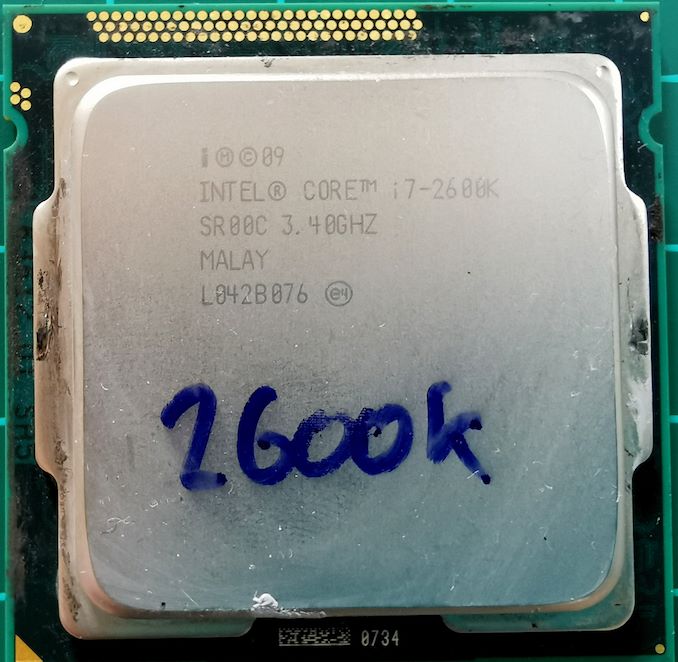

The Core i7-2600K: The Fastest Sandy Bridge CPU (until 2700K)
That product was Sandy Bridge. AnandTech scored the exclusive on the review, and the results were almost impossible to believe, for many reasons. In our results at the time, it was by far and above a leap ahead of anything else we had seen, especially given the thermal monstrosities that Pentium 4 had produced several years previous. Built on Intel’s 32nm process, the redesign of the core was a turning point in performance on x86, one which has not been felt since. It would be another 8 years for AMD to have its ‘Sandy Bridge’ (or perhaps more appropriately, a 'Conroe') moment with Ryzen. Intel managed to stand on the shoulders of its previous best product and score a Grand Slam.
In that core design, Intel shook things up considerably. One key proponent was the micro-op cache, which means that recently decoded instructions that are needed again are taken already decoded, rather than wasting power being decoded again. For Intel with Sandy Bridge, and more recently with AMD on Ryzen, the inclusion of the micro-op cache has done wonders for single threaded performance. Intel also launched into improving its simultaneous multi-threading, which Intel has branded HyperThreading for generations, slowly improving the core by making more of it dynamically allocated for threads, rather than static and potentially losing performance.
The quad-core design of the highest processor of the family on launch day, the Core i7-2600K, became a staple through Intel’s next five generations of the architecture, all the way through Ivy Bridge, Haswell, Broadwell, Skylake, and Kaby Lake. Since Sandy Bridge, while Intel has moved to smaller process nodes and taken advantage of lower power, Intel has been unable to recreate that singular jump in raw instruction throughput, with incremental 1-7% increases year on year, using that power budget to increase operational buffers, execution ports, and instruction support.
With Intel unable to recreate the uplift of Sandy Bridge, and with the core microarchitecture defining a key moment in x86 performance, users who purchased a Core i7-2600K (I had two) stayed on it for a long time. So much so in fact that a lot of people expecting another big jump became increasingly frustrated – why invest in a Kaby Lake Core i7-7700K quad-core processor at 4.7 GHz turbo when the Sandy Bridge Core i7-2600K quad core processor is still overclocked to 5.0 GHz?
(Intel’s answer was typically for power consumption, and new features like PCIe 3.0 GPUs and storage. But that didn’t sway some users.)
This is why the Core i7-2600K defined a generation. It had staying power, much to Intel’s initial delight then subsequent frustration when users wouldn’t upgrade. We are now in 2019, and appreciate that when Intel moved beyond four cores on the mainstream, if users could stomach the cost of DDR4, either upgraded to a new Intel system, or went down the AMD route. But how does the Core i7-2600K hold up to 2019 workloads and games; or perhaps even better, how does the overclocked Core i7-2600K fare?
Compare and Contrast: Sandy Bridge vs. Kaby Lake vs. Coffee Lake
Truth be told, the Core i7-2600K was not the highest grade Sandy Bridge mainstream desktop processor. Months after the 2600K launched, Intel pushed a slightly higher clocked 2700K into the market. It performed almost the same, and overclocked to a similar amount, but cost a bit more. By this time, users who had made the jump were on the 2600K, and it stuck with us.
The Core i7-2600K was a 32nm quad-core processor with HyperThreading, offering a 3.4 GHz base frequency and a 3.8 GHz turbo frequency, with a listed 95W TDP. Back then, Intel’s TDP was more representative: in our recent test for this article, we measured an 88W peak power consumption when not overclocked. The processor also came with Intel HD 3000 integrated graphics, and supported DDR3-1333 memory as standard. Intel launched the chip with a tray price of $317.
For this article, I used the second i7-2600K I purchased back when they were new. It was tested at both its out of the box frequency, and an overclocked frequency of 4.7 GHz on all cores. This is a middling conservative overclock – the best chips managed 5.0 GHz or 5.1 GHz in a daily system. In fact, I distinctly remember my first Core i7-2600K getting 5.1 GHz all-core and 5.3 GHz all-core during an overclocking event in the middle of the peak district one winter with a room temperature around 2C, where I was using a strong liquid cooler and 720mm of radiators. Unfortunately I crippled that chip over time, and now it won’t even boot at stock frequency and voltage. So we have to use my second chip, which wasn’t so great, but still a good representation of an overclocked processor. For these results, we also used overclocked memory, at DDR3-2400 C11.
It’s worth noting that since the launch of the Core i7-2600K, we have moved on from Windows 7 to Windows 10. The Core i7-2600K doesn’t even support AVX2 instructions, and wasn’t built for Windows 10, so it will be interesting to see where this plays out.
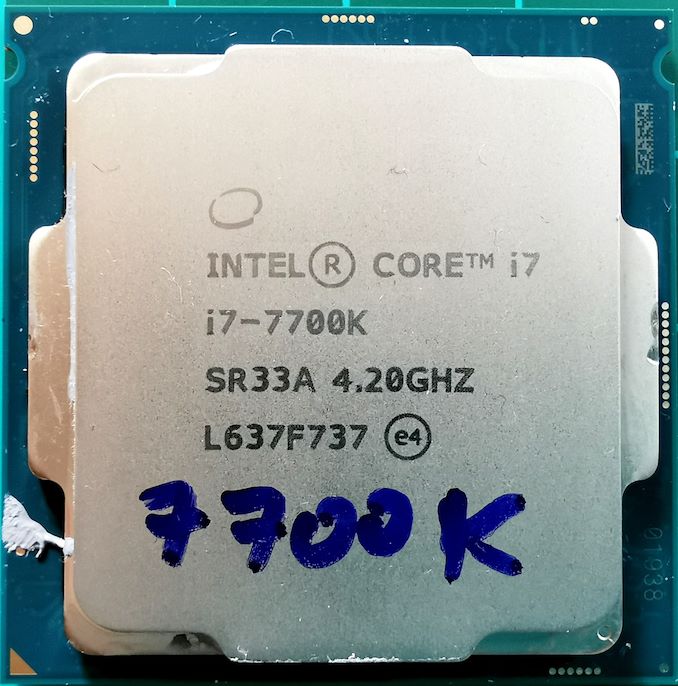
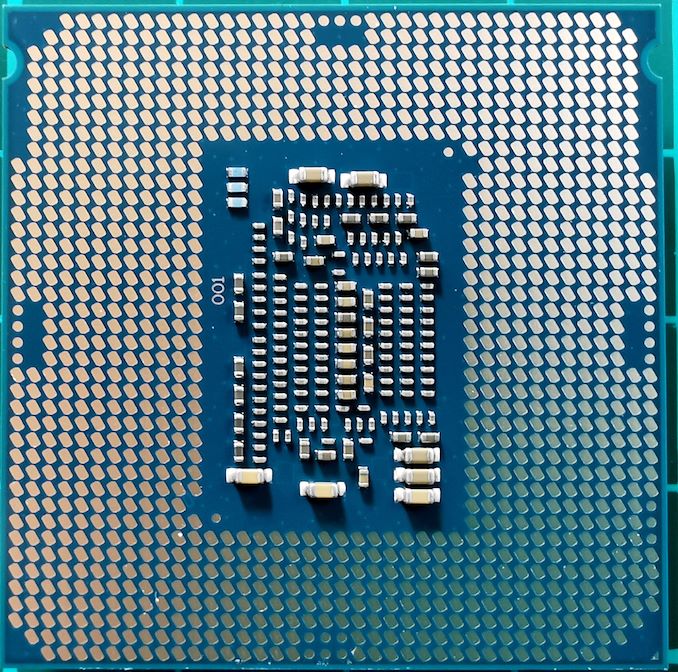
The Core i7-7700K: Intel's last Core i7 Quad Core with HyperThreading
The fastest and latest (final?) quad-core processor with HyperThreading that Intel released was the Core i7-7700K, which falls under the Kaby Lake family. This processor was built on Intel’s improved 14nm process, runs at a 4.2 GHz base frequency, and a 4.5 GHz turbo frequency. The 91W rated TDP, at stock, translated to 95W power consumption in our testing. It comes with Intel’s Gen9 HD 630 Graphics, and supports DDR4-2400 memory as standard. Intel launched the chip with a tray price of $339.
The Intel Core i7-7700K (91W) Review: The New Out-of-the-box Performance Champion
At the same time as the 7700K, Intel also launched its first overclockable dual core with hyperthreading, the Core i3-7350K. During that review, we overclocked the Core i3 and compared it directly to the out-of-the-box Core i7-2600K, trying to answer the question if Intel had managed to make a dual-core reach a similar performance to its old flagship processor. While the i3 had the upper hand in single threaded performance and memory performance, the two fewer cores ultimately made most tasks heavy work for the Core i3.
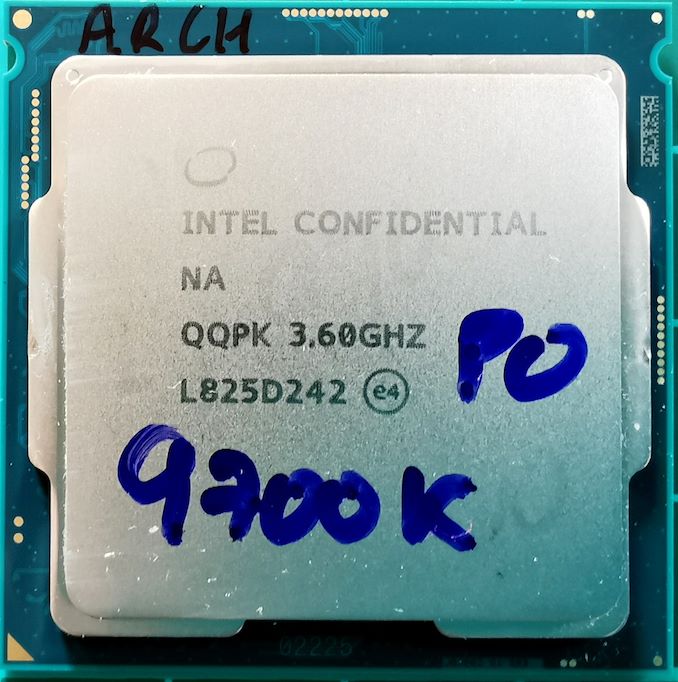
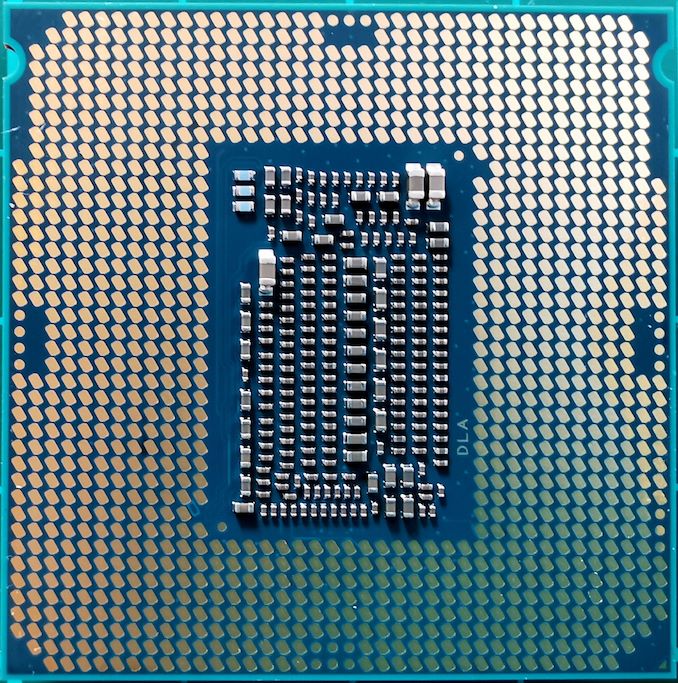
The Core i7-9700K: Intel's Latest Top Core i7 (now with 8 cores)
Our final processor for testing is the Core i7-9700K. This is not the flagship of the current Coffee Lake generation (which is the i9-9900K), but has eight cores without hyperthreading. Going for the 9900K with double the cores and threads is just a little overkill, especially when it still has a tray price of $488. By contrast, the Core i7-9700K is ‘only’ sold in bulk at $374, with a 3.6 GHz base frequency and a 4.9 GHz turbo frequency. The 95W TDP falls foul of Intel’s definition of TDP, and in a consumer motherboard will actually consume ~125W at full load. Memory support is DDR4-2666 as standard.
| Upgrading an Overclocked Intel Core i7-2600K Comparison CPUs |
||||
| Core i7-2600K |
Core i7-2600K at 4.7 GHz |
Core i7-7700K |
Core i7-9700K |
|
| Released | Jan 2011 | Jan 2011 | Jan 2017 | Oct 2018 |
| Price (1ku) | $317 | $317 | $339 | $374 |
| Process | 32nm | 32nm | 14nm | 14++ |
| uArch | Sandy Bridge | Sandy Bridge | Kaby Lake | Coffee Refresh |
| Cores | 4 plus HT | 4 plus HT | 4 plus HT | 8, no HT |
| Base Freq | 3.4 GHz | 4.7 GHz | 4.2 GHz | 3.6 GHz |
| Turbo Freq | 3.8 GHz | - | 4.5 GHz | 4.9 GHz |
| GPU Gen | 6 | 6 | 9 | 9.5 |
| GPU EUs | 12 | 12 | 24 | 24 |
| GPU Freq | 1350 | 1350 | 1150 | 1200 |
| DDR Support | DDR3-1333 | DDR3-2400 | DDR4-2400 | DDR4-2666 |
| PCIe | 2.0 x16 | 2.0 x16 | 3.0 x16 | 3.0 x16 |
| AVX | Yes | Yes | Yes | Yes |
| AVX2 | No | No | Yes | Yes |
| Thermal | Solder | Solder | Grease | Solder |
| TDP | 95 W | N/A | 91 W | 95 W |
The Core i7-2600K is stuck on DDR3 memory, has PCIe 2.0 rather than PCIe 3.0 support, and although not tested here, isn’t built for NVMe storage. It will be interesting to see just how close the overclocked results are to the Core i7-7700K in our tests, and how much of a direct uplift is seen moving to something like the Core i7-9700K.
Pages In This Review
- Tackling the Core i7-2600K in 2019
- Sandy Bridge: Inside the Core Microarchitecture
- Sandy Bridge: Outside the Core
- Test Bed and Setup
- 2018 and 2019 Benchmark Suite: Spectre and Meltdown Hardened
- CPU Performance: System Tests
- CPU Performance: Rendering Tests
- CPU Performance: Office Tests
- CPU Performance: Encoding Tests
- CPU Performance: Web and Legacy Tests
- Gaming: World of Tanks enCore
- Gaming: Final Fantasy XV
- Gaming: Civilization 6
- Gaming: Ashes Classic
- Gaming: Strange Brigade
- Gaming: Grand Theft Auto V
- Gaming: Far Cry 5
- Gaming: Shadow of the Tomb Raider
- Gaming: F1 2018
- Power Consumption
- Analyzing the Results
- Conclusions and Final Words












213 Comments
View All Comments
XXxPro_bowler420xXx - Saturday, May 11, 2019 - link
I am running a 3570 as my computer here at school. With a $50 1050Ti and 16gb of ram.godrilla - Friday, May 10, 2019 - link
I would love to see a 6 core i7 980xe overclocked to 4.3 ghz with 2 ghz 12 gig ram triple channel memory vs all these quad cores. < my rig. Playing all games at max settings for example shadow of Tomb Raider max settings at 3440x1440p getting 60fps gsync helps with frame variance smoothness. Metro Exodus extreme settings plus tesselation, physx and hairworks getting average 60fps same resolution with 1080ti ftw3.Ratman6161 - Friday, May 10, 2019 - link
"there is only one or two reasons to stick to that old system, even when overclocked. The obvious reason is cost"I have to disagree with that statement. My reason for my trusty 2600K still running is that its a wonderful "hand-me-down" system. I was running my 2600K as my primary system right up until I went Ryzen. At that point, my old system became my wife's new system. I toned down the overclock to 4.2 Ghz so I could slap a cheap but quiet cooler on it and for her uses (MS Office, email, web browsing, etc) it is a great system and plenty fast enough. My old Samsung 850 EVO SDD went along with it since in my newer system I've got a 960 EVO, but other than gaining that SSD along the way, its had no significant upgrades since 2011.
For someone who could easily get by on something like an i3-8100 or i5-7xxx, the 2600K hand-me-down is a great option.
WJMazepas - Friday, May 10, 2019 - link
My main PC still have a i5-760 so i believe its time to upgradexrror - Friday, May 10, 2019 - link
lol indeed!HStewart - Friday, May 10, 2019 - link
Personally I have not owned or cared for a desktop since my Dual Xeon 5150, it 12 years old and for a while until later i7's came out it was fastest machine in around. Back then I was into 3D rendering and even built a render farm - also serious into games with latest NVidia Graphics cards.But since then I went mobile and less graphics and try to less games but still like get out Command & Conquer and Company of Hero's - never much a first person shooter. So for me a higher end laptop would do me fine - for a longest time Lenovo Y50 was good - but Lenovo for me had build issues... but when the Dell XPS 13 2in1 came out it was great for some things portability was great and still use it because it nice to travel with documents and such. But I wanted a faster machine so when the Dell XPS 15 2in1 was announce, I jump onto bandwagon almost fully loaded 4k screen is probably a waste on it because I am getting older - graphics is slightly better than the 3 year old Y50, but CPU is extremely faster than the Lenovo. Some older games have trouble with GPU, and professional graphics like Vue 2016 have trouble with GPU.
But I will be 60 in couple of years and need to grow up from games.
I think my next computer is going to be something different, I want a portable always online - cellular device - I thought about a iPad with cellular but I think I am going wait for Lakefield device, small device with long battery life and connected. My experience with iOS and Android over time is always the same thing - great when first started out - but later there battery drop and performance drops with OS upgrades - when if you think about it no different than with Windows. Even though I am a technical person, never a Linux person - just does not fit with me even when I try it.
eva02langley - Friday, May 10, 2019 - link
GTA V is 5 years old... your game suites is horrible. At this point, I would just do a 3Dmark benchmark.Qasar - Saturday, May 11, 2019 - link
eva02... the games they test.. i dont even play them.....eastcoast_pete - Friday, May 10, 2019 - link
Thanks Ian! The most disappointing aspect of the newer Intel i7s vs. Sandy Bridge is the underwhelming progress on performance/Wh. How much more efficiency did the multiple changes in manufacturing and design really gain? Judging by the numbers, not that much. The amazing thing about Sandy Bridge was that it did boost performance, and did so at significantly improved perf/Wh. At this moment, we seem to be back to Athlon vs. P4 days: the progress is most noticeable with the chips that say "AMD" on them.Qwertilot - Friday, May 10, 2019 - link
In general, I think they did gain a lot of perf/Wh. Just not at the very top end. They've been pushing the clocks on the recent i7's incredibly hard.